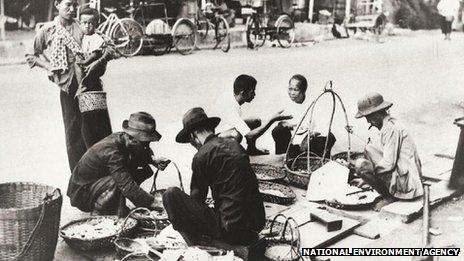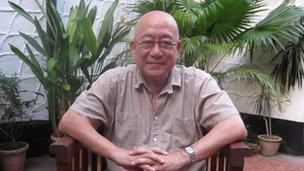Hawker* centres are Singapore's "community dining rooms" because it's where Singaporeans, regardless of race and background, can come together at one place to share an affordable plate of satay, carrot cake, or thosai.
Why are there hawker centres in Singapore?
Singapore's food courts, known locally as hawker centres, are popular with locals and tourists alike. But it all started when Singapore's migrants took up hawking in the 1950s and 1960s, and the government became concerned about hygiene, the former Public Health Commissioner Daniel Wang tells the BBC's Helier Cheung.
Singapore's hawker centres started partly for hygiene reasons, and to keep our water pollution in control. Singapore's street hawkers were polluting the water courses quite badly. We had a major problem with water pollution.
So we decided to relocate the street hawkers - putting them in hawker centres, with proper sewers, and providing them with basic amenities, like water, electricity, fridges, lighting and so forth.
Back when I first became public health commissioner, in 1979, the conditions were quite bad. The drains were all polluted, hawkers used basins to wash their soiled crockery, and you could see rats, cockroaches, and other animals running around.
At the time, people just accepted it because there was no alternative. In fact, when we moved street hawkers into hawker centres, initially, there was some criticism that the food was not as tasty anymore, because it was too hygienic!
I noticed that there were spittons under every table in the coffee shops - I had to put a ban to that and tell people you have to spit into your handkerchief and deposit it into a waste bin.
Also, I noticed that a lot of coffee shop food handlers would wear pajama pants, which were very untidy, so I said no more pajamas were to be worn.
I was told the reason why they were given pajama pants was because the pants had no pockets, so whatever money they got from the customers they had to pay to the cashier. But you know when you move around wearing pajama pants, you tend to forget that you didn't just get out of bed!
Initially we had to register all the street hawkers, and find a site near where they were operating [to relocate them to]. We had to give them an assurance that after they'd been relocated, no street hawkers would go back to their old spots.
All the assistants and food handlers would have to go through a basic hygiene course, and at the end of the course they had to sit through a small test to become a registered food handler.
Most of them passed the test first time - it covered common sense things like washing your hands before handling food.
We also decided to rate the hawker stalls for cleanliness and food handling, from A to D. If you reach D it means you've been suspended.
Eventually we noticed that hawker centres have become some kind of social gathering place where family and friends come. We didn't anticipate that that would take place [when we set up the hawker centres], but it turned out really well.
For me, the most interesting aspect of my work was the opportunity to see Singapore transform from a poor, underdeveloped state back in 1969 to [the developed city] it is today, 2021.
: Singaporean food culture is a point of pride, and incredibly multicultural. Each individual closet-sized hawker stalls—of which there could be hundreds in one center—specializes in a limited menu, and sometimes becomes renowned for a single dish, with a recipe passed down through generations. One uncle- or auntie-run stall may just serve stingray, the next could do Japanese comfort foods like katsu curry, the next, Singapore mainstay chicken rice, and so on. The best part of the experience as a traveler is putting your faith in the locals, who actively seek out queues to join in search of the best meal.
Eat well, live well;
Eat fast, live fast.
Eat poor live poor;
Eat slow, live slow.
Eat happily, live happily.
: We step into the lives of a handful of Singapore hawkers over 9 months of 2020 in the second season of this popular series. Oyster Omelette with oysters from Jeju, South Korea. A 90-year old recipe for sausages. Steaming Nasi Briyani with chicken or mutton. Basin Dish that requires 24 hours of prep and only eaten once a year. Crispy and light Appam, Singapore style. Charcoal Bun Barbeque Burgers.
Father-son, husband-wife, friends, grandaunt-niece hawkers of different generations reveal the loving recipes behind these dishes. Get a glimpse first-hand of their camaraderie, their quarrels and through it all, their unwavering support for each other. They also share the legacies and obstacles faced while trying to sustain their businesses.
And when COVID-19 hits, we track the hawkers’ shock, dismay and determination to weather through this storm. But initial optimism turns to worry, and fear as the months drag out. Will all of them be able to make it or will some end up folding for good?
: https://www.channelnewsasia.com/news/video-on-demand/belly-of-a-nation-2
Now the government is encouraging more Younger Generation to be food hawker in this island.
: Why did early immigrants create food uniquely Singaporean? What insights can hawkers give us to the making of some popular hawker dishes and what trials and tribulations await those in the trade and others getting into it for the very first time? How can our hawker culture carry on when the odds are stacked against it?
This 2-part documentary series goes into the hearts and minds of Singapore’s hawkers while paying homage to the amazing dishes that they serve. Going back into the past, we trace how ethnic lines were blurred by roving hawkers and continued to integrate in the hawker centre. But over the years, against the winds of change, eating hawker food in hot and humid centres fell out of fashion.
As the first generation stallholders pass on, who is going to carry their torch? We profile some of the brave and intrepid hawkerpreneurs, the new breed, who despite the odds think that they can make it and keep the hawker culture alive in Singapore.
https://www.channelnewsasia.com/news/video-on-demand/belly-of-a-nation
Please Pay When Your Food Is Served. Thank You Singaporeans For Delicious Servings.



No comments:
Post a Comment